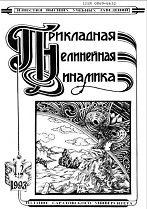|
This article is cited in 2 scientific papers (total in 2 papers)
APPLIED PROBLEMS OF NONLINEAR OSCILLATION AND WAVE THEORY
On the genetic divergence of two adjacent populations living in a homogeneous habitat
E. Ya. Frisman, M. P. Kulakov
Institute for Complex Analysis of Regional Problems, Far Eastern Branch, Birobidzhan, Russia
Abstract:
The purpose is to study the mechanisms leading to the genetic divergence, i.e. stable genetic differences between two adjacent populations coupled by migration of individuals. We considered the case when the fitness of individuals is strictly determined genetically by a single diallelic locus with alleles A and a, the population is panmictic and Mendel's laws of inheritance hold. The dynamic model contains three phase variables: concentration of allele A in each population and fraction (weight) of the first population in the total population size. We assume that the numbers of coupled populations change independently or strictly synchronously. In the first case, the growth rates are determined by fitness of homo- and heterozygotes, the mean fitness of the each population and the initial concentrations of alleles. In the second case, the growth rates are the same. Methods. To study the model, we used the qualitative theory of differential equations studies, including the construction of parametric and phase portraits, basins of attraction and bifurcation diagrams. We studied local bifurcations that provide the fundamental possibility of genetic divergence. Results. If heterozygote fitness is higher than homozygotes, then both populations are polymorphic with the same concentration of homologous alleles. If the heterozygotes fitness is reduced, then over time the populations will have the same monomorphism in one allele, regardless of the type of population changes. In this case, the dynamics is bistable. We showed that the divergence in the model is a result of subcritical pitchfork bifurcation of an unstable polymorphic state. As a result, the genetic divergent state is unstable and exists as part of the transient process to one of monomorphic state. Conclusion. Divergence is stable only for populations that maintain a population ratio in a certain way. In this case, it is preceded by a saddle-node bifurcation and dynamics is quad-stable, i.e. depending on the initial conditions, two types of stable monomorphism and divergence are possible simultaneously.
Keywords:
genetic divergence, differential equations, dynamics, saddle-node bifurcation, bi-stability, quad-stability.
Received: 08.04.2021
Citation:
E. Ya. Frisman, M. P. Kulakov, “On the genetic divergence of two adjacent populations living in a homogeneous habitat”, Izvestiya VUZ. Applied Nonlinear Dynamics, 29:5 (2021), 706–726
Linking options:
https://www.mathnet.ru/eng/ivp441 https://www.mathnet.ru/eng/ivp/v29/i5/p706
|

|




 Contact us:
Contact us: Terms of Use
Terms of Use
 Registration to the website
Registration to the website Logotypes
Logotypes








 Citation in format
Citation in format 
